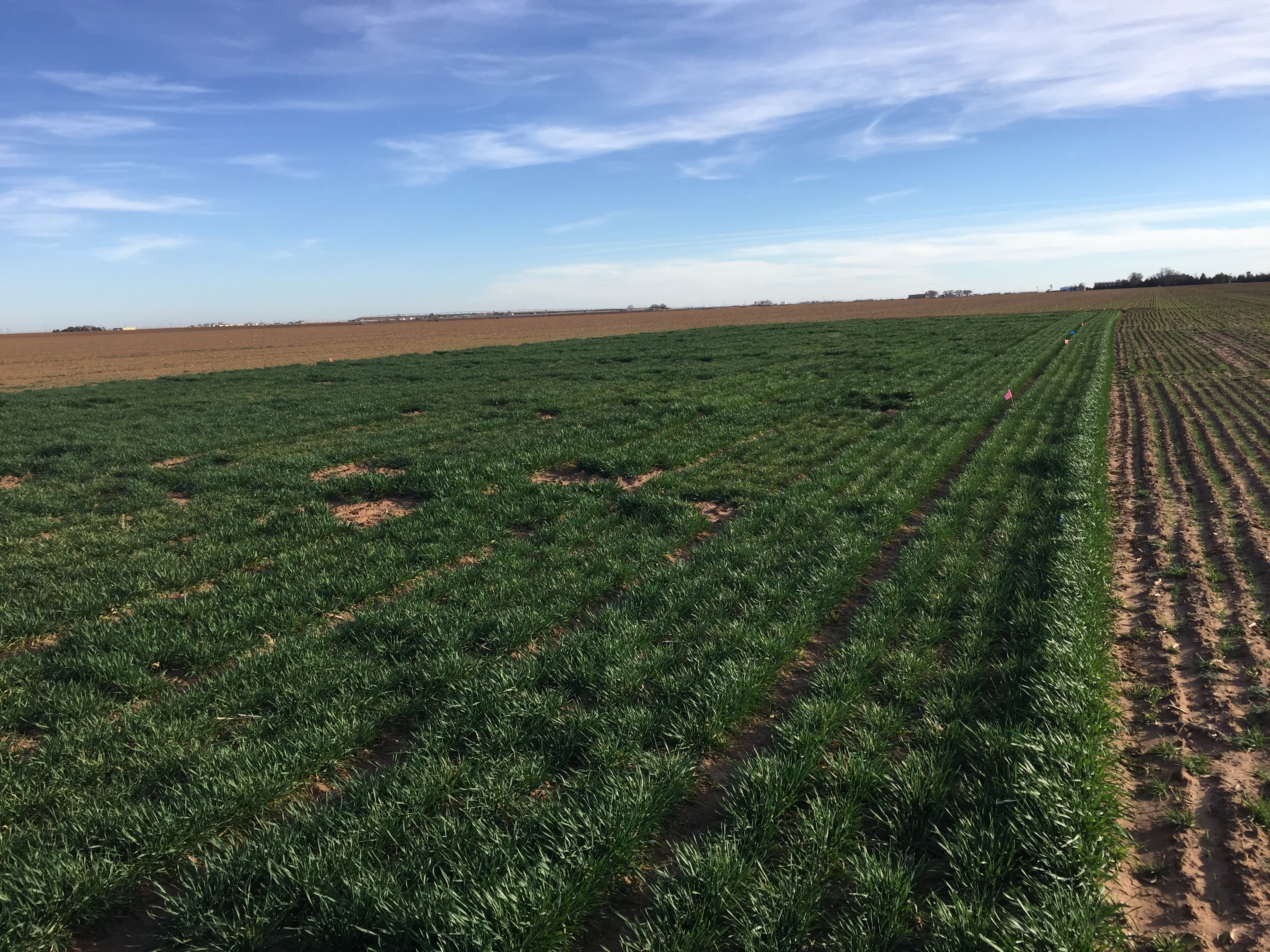by Dr. Calvin Trostle, Extension Agronomy, TAMU Soil & Crop Sciences, Lubbock, (806) 723-8432, ctrostle@ag.tamu.edu
Dr. Jourdan Bell, Extension Agronomy, TAMU Soil & Crop Sciences, Amarillo, (806) 677-5600, jourdan.bell@ag.tamu.edu
Texas A&M AgriLife Staff in Amarillo and Lubbock have designated our annual wheat grain variety “Picks” for the 2017-2018 Texas High Plains cropping season. Our ongoing Picks criteria include a minimum of three years of irrigated or dryland data in Texas A&M AgriLife High Plains wheat variety trials across numerous annual locations.
Also, a “Pick” variety means this: “Given the data these are the varieties we would choose to include and emphasize on our farm for wheat grain production.”
Picks are not necessarily the numerical top yielders as important disease resistance traits (leaf or stripe rust, wheat streak mosaic virus), insect tolerance (greenbugs, Russian wheat aphid, wheat curl mite), or standability can also be important varietal traits that enable a producer to better manage potential risk.
Table 1. Texas A&M AgriLife wheat grain variety Picks for the Texas High Plains based on yield performance and consistency based on over 30 multi-year, multi-site irrigated and dryland trials harvested in 2014-2017. Leaf rust and stripe rust reactions are included (see footnote).
|
Wheat Variety “Picks”, Texas High Plains. 2017-2018 |
||
| Full Irrigation# | Limited Irrigation | Dryland |
| TAM 112 (S/S)& | TAM 112 | |
| TAM 113 (R/R) | TAM 113 | TAM 113 |
| TAM 114 (MR/R) | TAM 114 | TAM 114 |
| TAM 304 (R/MR) | ||
| WB Grainfield (MR/R) | WB Grainfield | WB Grainfield |
| Iba (R/MR) | Iba | Iba |
| T158 (MS/MR) | T158 | |
| Winterhawk (MS/MR) | Winterhawk | Winterhawk |
#Full irrigation in the Texas & eastern NM High Plains reflects a production system that also is oriented to ample nitrogen fertilizer applications and likely fungicide application, in particular for leaf rust and stripe rust even when infection is minimal or perhaps even not evident (preventive applications).
&Leaf rust/stripe rust resistance ratings: R, Resistant; MR, moderately resistant; MS, moderately susceptible; and S, susceptible
There is only one change to new High Plains pick list for the forthcoming wheat cropping season.
Deletion in 2017
After a two-year debate, we removed TAM 111 as a limited irrigation and dryland Pick (removed as a full irrigation Pick for the 2015-2016 cropping season). It is important that producers understand the basis for our decision. Yes, TAM 111 remains by far the most widely planted variety in the Texas High Plains, but we observe increased inconsistent performance. It is still outstanding in some cases, especially high-input systems with optimum fertility and fungicide management, but poor in others. TAM 111 underperformance in some irrigated trials is as much as 20% below trial averages. The reduction in TAM 111 performance is in great part due to lack of any meaningful resistance or tolerance to leaf and especially stripe rust, the latter prevalent in the past three springs throughout much of the Texas High Plains. Our numbers no longer support TAM 111 as a Pick, especially when we have other Pick varieties less susceptible to the rusts (e.g., TAM 113, TAM 114, Iba, Grainfield).
Is it OK to still plant TAM 111?
Yes. There is a lot of saved seed and many producers will still purchase TAM 111 for the 2017-2018 cropping season. But be aware that TAM 111 success relative to other Pick varieties and wheat varieties in general may likely depend on drier conditions (less potential for rusts) and use of a fungicide even if infection levels are light or even simply as preventative (which we wouldn’t recommend for a moderately resistant or resistant variety)—we recommend you budget a fungicide application for TAM 111 on both irrigated and dryland. Given these concerns AgriLife urges producers to at least consider reducing any high percentage of your overall acres of this one variety.
For Further Discussion
Additional discussion of the wheat grain variety Picks is posted at http://lubbock.tamu.edu/programs/crops/wheat/ By mid-August we will have the supporting tables calculated that provide not only the annual results from the 2017 harvest but also all available two-, three-, and four-year regional averages for yield and test weight across both irrigated and dryland trials in the High Plains. In addition, the online information includes:
- A special note on individual varieties (TAM 112, TAM 304, and beardless TAM 204).
- The advantage of variety Picks in multi-year wheat grain production
Wheat Variety Grain Picks for Other Texas Regions
Dr. Emi Kimura, Vernon, (940.552.9941, emi.kimura@ag.tamu.edu) compiles the Picks for the Rolling Plains, and Dr. Clark Neely, state small grains extension agronomist, College Station (979.862.1412, cbn108@tamu.edu) compiles our Picks for the Texas Blacklands (including northeast Texas), and South Texas. See their forthcoming 2017-2018 Picks lists at http://varietytesting.tamu.edu/wheat/
For additional information about wheat varieties and small grains production in Texas, consult http://varietytesting.tamu.edu/wheat/
Fig. 1. Dryland wheat variety trial near Lubbock, TX on Feb. 10, 2017 that went on to average 41 bu/A.

Calvin Trostle
Professor and Extension Specialist
Lubbock, TX
803.746.6101
ctrostle@ag.tamu.edu
